As this thread is about JC preamp (some time) this preamp is something different from JC recycled for years. http://www.diyaudio.com/forums/solid-state/235695-no-nfb-line-amp-gainwire-mk2-76.html#post4348738
Luckythedog, you surely must have references to this novel explanation. I don't know what flex waves are, my books on speakers don't mention it, I have never heard it mention in conversations I had on this topic, Google thinks flex waves are something for a guitar, so I am at a loss. Frankly speaking, I think you are making things up.
And yet there is:
Goebel High End
//
It is:"Group Delay, Excess Delay, and Overall Time Delay" that was to be published. Anybody ever see a copy?
In his AES article he constantly references this paper I have never seen. No wonder there is so much confusion
Is it this one?
George
Attachments
So if I read this right, you can correct for delay, electrically or mechanically, and use multiple drivers/types as long as you account for the shortcomings of each driver.
However, the correction has a specifically limited area of effect where the correction and desired response will be observed as a single response instead of the individual imperfect ones.
So dropping stones in a circular pond at different places from the same height but different weights and sizes can result in an area that happens to be of the desired response, but depending on all the variables, so will the area of desired effect vary.
This sounds like it is part of how to break up kidney stones when you sit in an water tank of known dimensions without completely injuring all your internal organs, and if light travels in waves too... perhaps how the laser that cuts out your tumors knows when, where and how to "cross the streams" inside your brain.
However, the correction has a specifically limited area of effect where the correction and desired response will be observed as a single response instead of the individual imperfect ones.
So dropping stones in a circular pond at different places from the same height but different weights and sizes can result in an area that happens to be of the desired response, but depending on all the variables, so will the area of desired effect vary.
This sounds like it is part of how to break up kidney stones when you sit in an water tank of known dimensions without completely injuring all your internal organs, and if light travels in waves too... perhaps how the laser that cuts out your tumors knows when, where and how to "cross the streams" inside your brain.
Last edited:
BTW -- I received the new book (1st printing 2015) -- Communication Acoustics by publisher J.Wiley. It backs up the numbers and expands --- 3-5mS are good numbers to design with. That is for music signals and headphones or low reverb environment with speakers and good direct to reflect radio listening position. We can JND GD to 0.3-0.4 ms in anechoic environment. Within a best of 1mS within a critical band.
THx-RNMarsh
THx-RNMarsh
TNT.
I worked with someone on a desktop version of a flat panel bending wave speaker. Lots of issues with that and getting a wide bandwidth is just about impossible. The edge termination is a major issue and so is the radiation pattern. For nearfield you can get away with some of it but at best it sounded like low-fi sound, nothing to write home about.
I worked with someone on a desktop version of a flat panel bending wave speaker. Lots of issues with that and getting a wide bandwidth is just about impossible. The edge termination is a major issue and so is the radiation pattern. For nearfield you can get away with some of it but at best it sounded like low-fi sound, nothing to write home about.
the question of the propagation speed of the acceleration of the voice through the cone boils down to: is it a plate, or a solid.
There are thirteen articles (in red, see attachment) on cones, materials, propagation modes, velocities and all in the AES Anthology Loudspeakers Volume 2 alone.
What can we say more?
And there is a lot of work behind each of these articles (e.g.)
http://repository.tudelft.nl/assets/uuid:b3d96462-a45a-4aa7-b867-ff34e63f790d/P_1804_5211.PDF
George
>Edit. You are welcome Mr. Curl
This one too
http://projekter.aau.dk/projekter/files/9797324/report_07gr1064.pdf
and this
http://mue.music.miami.edu/wp-content/uploads/2013/10/MastersThesisDaisukeKoya.pdf
Attachments
Last edited:
I giggled when a story about a teardown of the Amazon Echo had a comment from someone who took Amazon to task for not using an NXT transducer.TNT.
I worked with someone on a desktop version of a flat panel bending wave speaker. Lots of issues with that and getting a wide bandwidth is just about impossible. The edge termination is a major issue and so is the radiation pattern. For nearfield you can get away with some of it but at best it sounded like low-fi sound, nothing to write home about.
TNT.
I worked with someone on a desktop version of a flat panel bending wave speaker. Lots of issues with that and getting a wide bandwidth is just about impossible. The edge termination is a major issue and so is the radiation pattern. For nearfield you can get away with some of it but at best it sounded like low-fi sound, nothing to write home about.
How does bending wave differ from ESD. All I read about ESD is the fidelity of mid and highs.
TNT.
I worked with someone on a desktop version of a flat panel bending wave speaker. Lots of issues with that and getting a wide bandwidth is just about impossible. The edge termination is a major issue and so is the radiation pattern. For nearfield you can get away with some of it but at best it sounded like low-fi sound, nothing to write home about.
I have built a pair of blatant ripoffs made of carbon composite with the slits and all. Sound really good and some properties are exceptional so "hi-fi" for sure. There are occasional buzz at very demanding material so some more tweaking to do with physical termination. Its still under development. I run them from 400z and all the way up eq:ed by DSP.
//
I have built a pair of blatant ripoffs made of carbon composite with the slits and all. Sound really good and some properties are exceptional so "hi-fi" for sure. There are occasional buzz at very demanding material so some more tweaking to do with physical termination. Its still under development. I run them from 400z and all the way up eq:ed by DSP.
Sad, that site might have some interesting ideas, but the cable nonsense lowers their street cred. Never miss a chance to hose your customers.
Thanks, I had missed that one, interesting concept.
Sad, that site might have some interesting ideas, but the cable nonsense lowers their street cred. Never miss a chance to hose your customers.
Agree strongly. Never even looked at that part.
//
Binely,
There really isn't much in common at all between the bending wave speakers and an electrostatic speaker. Totally different way to drive a diaphragm. With the bending mode speaker you still have a conventional motor design with a permanent magnet motor attached to the back of the membrane. The speaker I worked on used Kapton as the diaphragm and that alone was a PITA. Attaching that to the frame was something I had to design for them, otherwise they were fracturing the Kapton. There were a couple of driver motors in different locations across the diaphragm. There are so many problems with the idea, the only advantage if any was that you could make the entire speaker very thin like a flat screen TV otherwise it was stupid in my eyes.
There really isn't much in common at all between the bending wave speakers and an electrostatic speaker. Totally different way to drive a diaphragm. With the bending mode speaker you still have a conventional motor design with a permanent magnet motor attached to the back of the membrane. The speaker I worked on used Kapton as the diaphragm and that alone was a PITA. Attaching that to the frame was something I had to design for them, otherwise they were fracturing the Kapton. There were a couple of driver motors in different locations across the diaphragm. There are so many problems with the idea, the only advantage if any was that you could make the entire speaker very thin like a flat screen TV otherwise it was stupid in my eyes.
What I found almost bizarre with the NXT people was that they touted the thin part as if this was some advantage for desktop speakers---while what's far more valuable is the width such speakers consume. And of course the bass was very limited. Bad idea IMO.There are so many problems with the idea, the only advantage if any was that you could make the entire speaker very thin like a flat screen TV otherwise it was stupid in my eyes.
There are thirteen articles (in red, see attachment) on cones, materials, propagation modes, velocities and all in the AES Anthology Loudspeakers Volume 2 alone.
What can we say more?
And there is a lot of work behind each of these articles (e.g.)
http://repository.tudelft.nl/assets/uuid:b3d96462-a45a-4aa7-b867-ff34e63f790d/P_1804_5211.PDF
George
George, indeed a lot has been written on this subject. The thesis you linked to says exactly the same thing I have been saying all along:
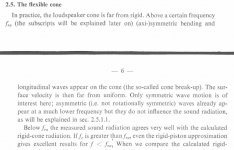
And on page 9:

So, below the break up frequency, there are no bending waves. It is definitional.
To come back to the original question, how fast does movement of the voice coil move through the cone. Below break up, in the absence of bending waves, the only mechanism can be a longitudinal wave, which necessarily propagates with the speed of sound (in that material) through the cone material. My original point, disputed by Luckythedog, now ready to be put to rest I hope.
real CD s/n.
Some measured CD S/N info -- I recorded some ultra pure sine wave freqs onto CD then played that CD back - using same transport - into distortion analyzer and got these results which are not discussed in the specs. Note: This is a machine designed for Mastering (ML-9600). ).
The noise started rising above 1KHz at a constant slope of about 6dB per octave started at -88dB (30KHz BW) to -70dB. At >20 KHz the out of band noise jumped up further. In actual recording, the record level would be lower and thus worse S/N. Also, a spike at 93KHz... might be from smps being used.
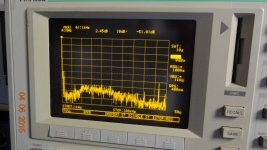
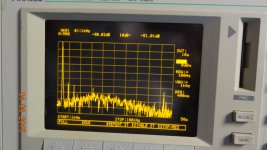
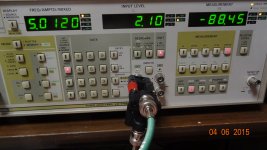
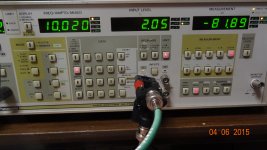
Seems it could use some out of band filtering to prevent IM.
THx-RNMarsh
Some measured CD S/N info -- I recorded some ultra pure sine wave freqs onto CD then played that CD back - using same transport - into distortion analyzer and got these results which are not discussed in the specs. Note: This is a machine designed for Mastering (ML-9600). ).
The noise started rising above 1KHz at a constant slope of about 6dB per octave started at -88dB (30KHz BW) to -70dB. At >20 KHz the out of band noise jumped up further. In actual recording, the record level would be lower and thus worse S/N. Also, a spike at 93KHz... might be from smps being used.




Seems it could use some out of band filtering to prevent IM.
THx-RNMarsh
Last edited:
Kindhornman, Simon7000, Luckythedog, other's:
I find the cone/motor stuff fascinating. I had a couple of questions
since we are on the topic. Please feel free to correct any misunderstandings
that I might have.
Cone Speaker Question
I thought the speaker deformation (and whatever you had described in
measuring watching, etc. at the various laboratories) was primarily caused
by a mis match in compliance of the surround and spider relative to the cone.
That deformation happened at mismatched or only when driving beyond capability
and this caused distortion...or some types of distortion. Then, the design of hemp
cones to stiffen the cone even more while being lighter than paper and other types
of cone material, etc.
Compression Driven Horn Question
I was surprised when I head this, and I'm not sure I believe it or it is a guy
trying to get people to buy his stuff.
I have some Klipsch Cornwall's, actually Cornwall 2s that I've modded, deadened
the squawker (mid bass) and tweeter, revised the crossover and if I recall have the
hardwood to the center of the back cabinet along with epoxing a plate of 16 gauge
steel to the inside with appropriate cut outs for driver clearance, magnetism, and to allow
batting etc to be reused.
So I play some music through a different amp, NAD 720BEE and find that where
I listen to it at a fairly healthy level I get that drilled, solid state type distortion
that will lead me to an ear ache/head ache.
I put my Dynaco Stereo 70 Series II amp in and don't have that problems unless I just
crank it up to 3/4 full on the pre amp.
Looking around at various other sites I came across an RF guys website and he's
describing what I'm going through as not a problem with the squawker compression
driver being the problem but that it is the actual horn that is the problem. That it
is well known and by cutting up my speaker and replacing the horn with one of his
wooden horns that is more square than rectangular.
General Capacitor Crossover Question
(okay, it was a couple of questions + one)
To compound my concerns are when I review his website he is using many
metalized film caps in the crossover. I have been schooled by our own
RNMarsh about the use of metalized film caps in crossovers and how
that is a no no due to metalized spray on film (starts moving or migrating
for lack of a better defined term[my paraphrase] causing higher distortion
than film and foil caps. Does it matter if the metalized caps are just
used for shunting? Or Even if shunting they are still in the cross
over network?
Your thoughts and comments welcome.
Cheers,
I find the cone/motor stuff fascinating. I had a couple of questions
since we are on the topic. Please feel free to correct any misunderstandings
that I might have.
Cone Speaker Question
I thought the speaker deformation (and whatever you had described in
measuring watching, etc. at the various laboratories) was primarily caused
by a mis match in compliance of the surround and spider relative to the cone.
That deformation happened at mismatched or only when driving beyond capability
and this caused distortion...or some types of distortion. Then, the design of hemp
cones to stiffen the cone even more while being lighter than paper and other types
of cone material, etc.
Compression Driven Horn Question
I was surprised when I head this, and I'm not sure I believe it or it is a guy
trying to get people to buy his stuff.
I have some Klipsch Cornwall's, actually Cornwall 2s that I've modded, deadened
the squawker (mid bass) and tweeter, revised the crossover and if I recall have the
hardwood to the center of the back cabinet along with epoxing a plate of 16 gauge
steel to the inside with appropriate cut outs for driver clearance, magnetism, and to allow
batting etc to be reused.
So I play some music through a different amp, NAD 720BEE and find that where
I listen to it at a fairly healthy level I get that drilled, solid state type distortion
that will lead me to an ear ache/head ache.
I put my Dynaco Stereo 70 Series II amp in and don't have that problems unless I just
crank it up to 3/4 full on the pre amp.
Looking around at various other sites I came across an RF guys website and he's
describing what I'm going through as not a problem with the squawker compression
driver being the problem but that it is the actual horn that is the problem. That it
is well known and by cutting up my speaker and replacing the horn with one of his
wooden horns that is more square than rectangular.
General Capacitor Crossover Question
(okay, it was a couple of questions + one)
To compound my concerns are when I review his website he is using many
metalized film caps in the crossover. I have been schooled by our own
RNMarsh about the use of metalized film caps in crossovers and how
that is a no no due to metalized spray on film (starts moving or migrating
for lack of a better defined term[my paraphrase] causing higher distortion
than film and foil caps. Does it matter if the metalized caps are just
used for shunting? Or Even if shunting they are still in the cross
over network?
Your thoughts and comments welcome.
Cheers,
- Status
- Not open for further replies.
- Home
- Member Areas
- The Lounge
- John Curl's Blowtorch preamplifier part II